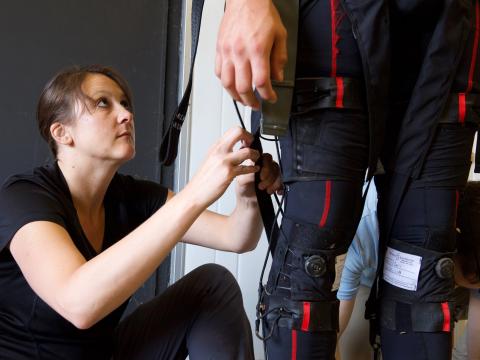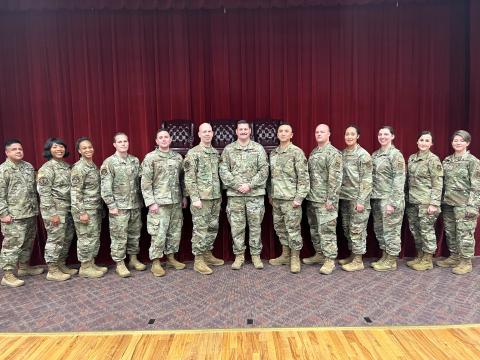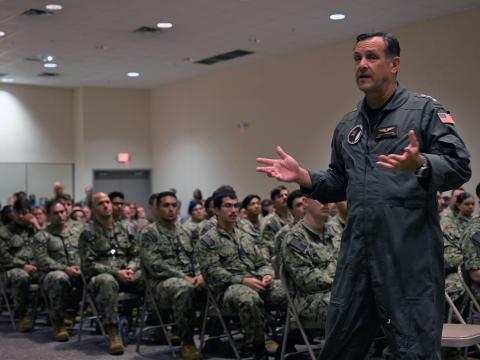Waging an Unmanned Hunt
The Heron unmanned aerial vehicle (UAV) takes off from an airport in El Salvador as part of a cooperative concept evaluation involving UAVs and illegal drug interdiction. The U.S. Southern Command (SOUTHCOM) innovation sector has been examining the usefulness of air, sea and underwater unmanned craft
In the air and at sea, remote-control vehicles stem the illegal narcotics tide. 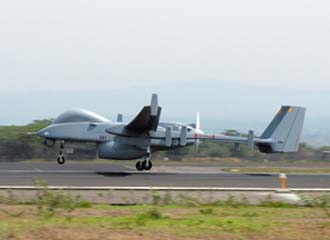
in the war against drug trafficking in its area of responsibility.
In the war against illicit drug trafficking, the U.S. Southern Command is employing unmanned weapons that are disrupting the operations of drug-running organizations. By combining remotely controlled air, surface and subsurface vehicles to monitor criminals moving drugs from South America northward, the
Despite these challenges of change, military innovation leaders at the Southern Command (SOUTHCOM),
Although the statistics remain a moving target, experts estimate that illegal drugs are being transported primarily via sea—on boats, semisubmersibles and speedboats—and to a lesser degree via aircraft. To combat this assault on all levels, Lt. Col. Jon Ross,
Col. Ross relates that the interest in USVs increased after the USS Cole incident in 2000. As a result of the attack on the ship while docked in
Improvements to unmanned systems continued to increase, and in 2007, SOUTHCOM’s innovation office decided to employ the same USV platforms but in a different way. The command was the first to use them to interdict drug trafficking. The command decided to use rigid hull inflatable boats, or RHIBs, that featured electro-optical and infrared radar as well as a communications suite that it operated in its area of responsibility. An exercise with the
The colonel explains that drug interdiction comprises two aspects. The first is detection and monitoring; the second is interdiction and apprehension. While the U.S. Defense Department is the lead agency in many former activities, the latter actions must be coordinated and performed by local law enforcement agencies. To ensure seamless collaboration, SOUTHCOM’s personnel diligently work to create partnerships with each nation in its area of responsibility, Col. Ross notes.
The use of unmanned systems in many of the countries in the region has practical benefits for both the
In addition to supporting local economies through sound resource management, using unmanned systems in the region significantly increases the amount of stake-out time around the overall area. Unmanned vehicles can loiter for hours economically because they are not affected by weather, emotions, sleep requirements or time of day, and they “do not need retirement benefits,” the colonel quips. In addition, these vehicles are particularly beneficial to partner nations that have limited assets. “If we can increase their [partner nations’] capacity and ability to act on their own, that is ultimately the goal,” Col. Ross emphasizes.
During tests of the Fire Scout vertical takeoff and landing UAV onboard the USS McInerney, the aircraft’s operator had the opportunity to use the UAV to track a "go-fast" boat on its way to a drug transfer meeting in the Atlantic Ocean. A U.S. Coast Guard law enforcement detachment aboard the McInerney apprehended the alleged drug traffickers.
Evaluations of the use of UAVs to counter drug operations took place in partnership with 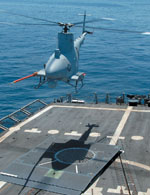
The month-long event, which SOUTHCOM called Project Cazador, also revealed a requirement to increase unmanned systems’ value in the fight against illegal drug activity by extending communications range capabilities, Col. Ross shares. Project Cazador included only line-of-sight communication capabilities, limiting communications to distances of no more than nine nautical miles. Col. Ross and his team concluded that unmanned vehicles would be more valuable assets by installing beyond-line-of-sight communications capabilities, most likely tapping into satellites.
This summer, SOUTHCOM’s innovation office was preparing to brief this extended communications project to the Defense Department’s Director of Defense Research and Engineering. The proposal would allow continued investigation of the use of unmanned systems against asymmetric threats in its region, the colonel reveals. Additional concept evaluations may include connecting three USVs and using the collective data to increase situational awareness of specific targets, he explains.
Testing of the effectiveness of a Fire Scout vertical takeoff and landing unmanned aerial vehicle (VTUAV) and drug interdiction activities earlier this year not only demonstrated its usefulness, but ultimately resulted in the capture of drug traffickers transporting their goods. While undergoing testing and evaluation traveling aboard the USS McInerney, and while working in concert with a U.S. Coast Guard law enforcement detachment, the Fire Scout was the eye in the sky tracking a speedboat—called a “go-fast”—suspected of carrying narcotics that the McInerney had acquired on its radar.
After completing the Fire Scout tests, the mission payload operator was granted permission to use the VTUAV to guide the pursuit of the go-fast. Because of its small profile and state-of-the-art optics, the Fire Scout covertly gathered video of the speedboat and fed it to the operator on the ship in real time. Ultimately, the VTUAV captured video of the speedboat meeting a fishing vessel for what appeared to be a refueling and logistics transfer. However, when the McInerney pulled up and the Coast Guard law enforcement officials boarded the boat, they seized approximately 60 kilograms of cocaine and caused the alleged drug traffickers to throw approximately 200 kilograms of narcotics overboard.
Col. Ross points out that, like other nonstate rogue actors, the drug trafficking organizations are not attacking the
But the colonel points out that technical superiority is not the only advantage needed in the battle against the drug trade. Information also is a game-changer, and high-speed communications capabilities enable data to travel at the speed of light. Although fast information sharing increases situational awareness, it also benefits adversaries as they use it to become aware of the availability of the latest technologies instantaneously, then either purchase them or create a way to evade them.
According to Col. Ross, the increased loiter times that unmanned systems provide help counteract this particular advantage. First, they enable the
The colonel reveals that one of the latest significant threats in the SOUTHCOM area of responsibility is the drug lords’ use of self-propelled semisubmersibles (SPSSs) to transport cocaine. These minisubmarines cost between $250,000 and $300,000, which is a small price for drug trafficking organizations with plentiful financial resources. Col. Ross notes that the use of these vehicles may require the
Even with the limited number of unmanned systems SOUTHCOM currently is exploring, the command has been significantly successful in affecting how drug trafficking organizations behave. Without free reign in the air or on the sea, these criminals are forced to transport their products over land. This mode of transportation is not only more time-consuming but also more expensive and increases the risk of being apprehended, the colonel explains. Unfortunately, the citizens of nations they now travel through must deal with an unintended consequence of drug running interdiction. It is not the drugs themselves that cause the disturbances, the colonel allows, but rather the crime that surrounds it as these marauders make their way through countrysides. This is one problem that has not yet been resolved.
Although unmanned systems are now somewhat commonplace in operations in southwest
WEB RESOURCES
Self-propelled semisubmersibles: http://bit.ly/9fEjqX
Heron UAV: http://bit.ly/9lxSSl
Fire Scout UAV: http://bit.ly/9xVRu2
Northrop Grumman Aerospace Systems: www.as.northropgrumman.com/index.html
